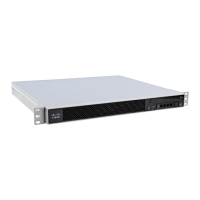1-50
Cisco ASA Series CLI Configuration Guide
Chapter 1 Configuring a Cluster of ASAs
Managing ASA Cluster Members
Detailed Steps
Changing the Master Unit
Caution The best method to change the master unit is to disable clustering on the master unit (see the “Becoming
an Inactive Member” section on page 1-48), waiting for a new master election, and then re-enabling
clustering. If you must specify the exact unit you want to become the master, use the procedure in this
section. Note, however, that for centralized features, if you force a master unit change using this
procedure, then all connections are dropped, and you have to re-establish the connections on the new
master unit. See the “Centralized Features” section on page 1-18 for a list of centralized features.
Command Purpose
Step 1
For a slave unit:
cluster group cluster_name
no enable
Example:
hostname(config)# cluster group cluster1
hostname(cfg-cluster)# no enable
Disables clustering. You cannot make configuration changes
while clustering is enabled on a slave unit.
Step 2
clear configure cluster
Example:
hostname(config)# clear configure cluster
Clears the cluster configuration. The ASA shuts down all
interfaces including the management interface and cluster control
link.
Step 3
no cluster interface-mode
Example:
hostname(config)# no cluster
interface-mode
Disables cluster interface mode. The mode is not stored in the
configuration and must be reset manually.
Step 4
If you have a backup configuration:
copy backup_cfg running-config
Example:
hostname(config)# copy backup_cluster.cfg
running-config
Source filename [backup_cluster.cfg]?
Destination filename [running-config]?
hostname(config)#
Copies the backup configuration to the running configuration.
Step 5
write memory
Example:
hostname(config)# write memory
Saves the configuration to startup.
Step 6
If you do not have a backup configuration, reconfigure management access according to Chapter 1, “Getting
Started.” Be sure to change the interface IP addresses, and restore the correct hostname, for example.

